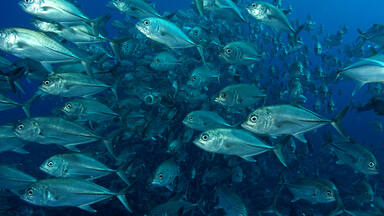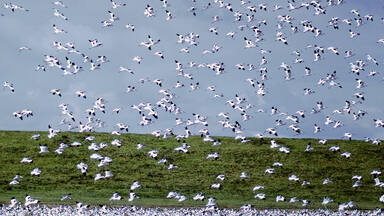West Norwegian Fjords and Glacier Bay join forces to strengthen conservation in marine World Heritage
Last month, the Marine World Heritage Programme traveled to Norway to facilitate an exchange between the West Norwegian Fjords - Geirangerfjord and Nærøyfjord and Glacier Bay National Park.
These two marine World Heritage sites share a challenge and an opportunity: both are popular cruise ship destinations and are threatened by pollution from tourism traffic. In Glacier Bay, a competitive bidding process limits the number of ships that can access the bay, requires strict environmental controls to reduce impacts on local water quality and wildlife, and generates half of the site’s operating revenue. Site managers from the Norwegian Fjords have been working hard to build a greener, more sustainable tourism industry. The August visit was a chance for the site managers to share their experiences and ideas and chart a course for a more sustainable future.
When managers from the two sites met at the first Marine World Heritage site manager’s conference in Honolulu in 2010, they realized that at least seven major international cruise lines visit both sites. This gave them the idea to work together on win-win strategies that limit the environmental impacts of cruise ship traffic while harnessing the visibility and revenue it can provide.
West Norwegian Fjords - Geirangerfjord and Nærøyfjord, inscribed on UNESCO’s World Heritage List in 2005, is renowned for its spectacular beauty. The fjords reach underwater depths of more than 500 meters, and are host to seals, dolphins, and whales. Visitors flock to the area in the summer months, many by cruise ship, and the ships' smoke stacks pollute the air. Site managers have been working on a Green Fjord initiative to facilitate “transport without a trace.” It includes electric scooters, zero emission cars and public transportation and green technology innovation that could provide a boost to the region's private companies. Mitigating the ecological footprint of the cruise ships is a critical step in realizing a zero-emissions future for the fjords.
“We have identified challenges which Glacier Bay may already have found sustainable solutions for; therefore it is extremely important for us to move forward with a partnership where we can learn more from the best practices in Glacier Bay,” said Katrin Blomvik, manager of the West Norwegian Fjords. “Our goal for the future is to find sustainable solutions to our challenges through new partnerships and moving forward with our Green Fjord initiative. We believe that green technology can solve some of our great challenges and also give us new green opportunities for small, livable communities and businesses. We believe that our sites together have a unique possibility to position Marine World Heritage sites as leading examples across the globe for marine protected area management.”
Glacier Bay National Park, inscribed in 1979, has over 25 years of experience managing cruise ship traffic. Its competitive tourism visitation system is one of the most innovative in the world (read more about it on page 32 of the new Best Practice Guide). It controls the kinds of fuel or motors ships can use to reduce air pollution, requires ships to refrain from discharging wastewater in the bay, and includes a whale avoidance program and an optional interpretive program that places park staff on ships to educate visitors. The fees collected from cruise ships are a critical revenue source for Glacier Bay, generating nearly 50% of the park’s management budget.
“Glacier Bay and West Norwegian Fjords have very similar physical and marine environments. Both share similar patterns of tourism, especially cruise tourism. Both share cultural connections of people to the lands over many centuries. It is the desire of both World Heritage sites to maintain local communities as livable places, manage tourism sustainably, and prioritize connections with the next generation of stewards,” said Philip N. Hooge, Superintendent of Glacier Bay National Park and Preserve. “Glacier Bay was able to share the challenges, successes and stumbles on its three-decade journey to arrive at the current very successful model of cruise industry management in the World Heritage site. I have not witnessed a better opportunity for two World Heritage sites anywhere, whether they were in the same country or not, to use partnership and mutual learning to improve their site management.”
The August visit was just one step in what is intended to be a long and fruitful relationship between these two sites. The Marine World Heritage Programme will be sharing their learning with the many other marine sites in its network that are accessed by cruise ship, as well as those working to reduce environmental impacts from other tourism vehicles.





